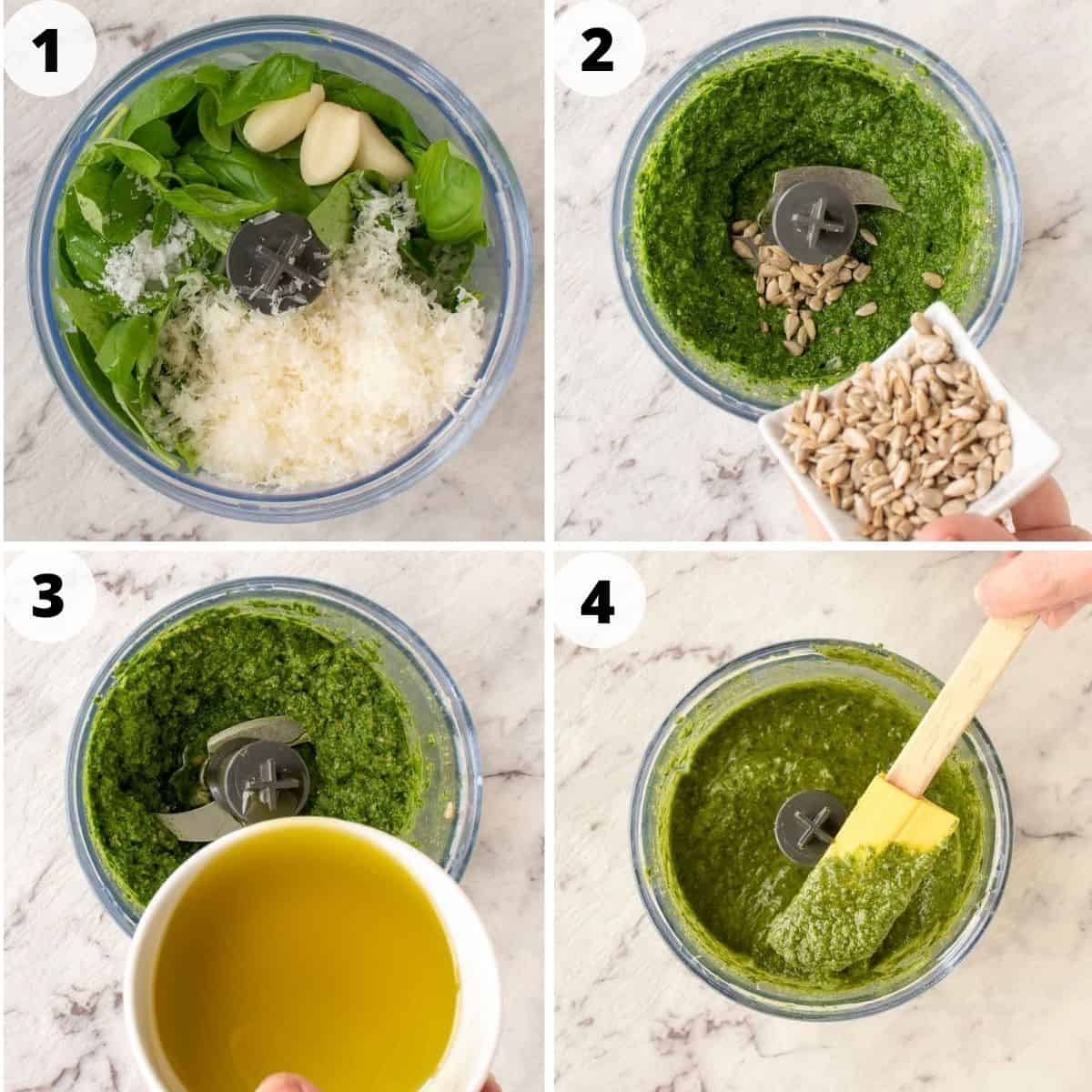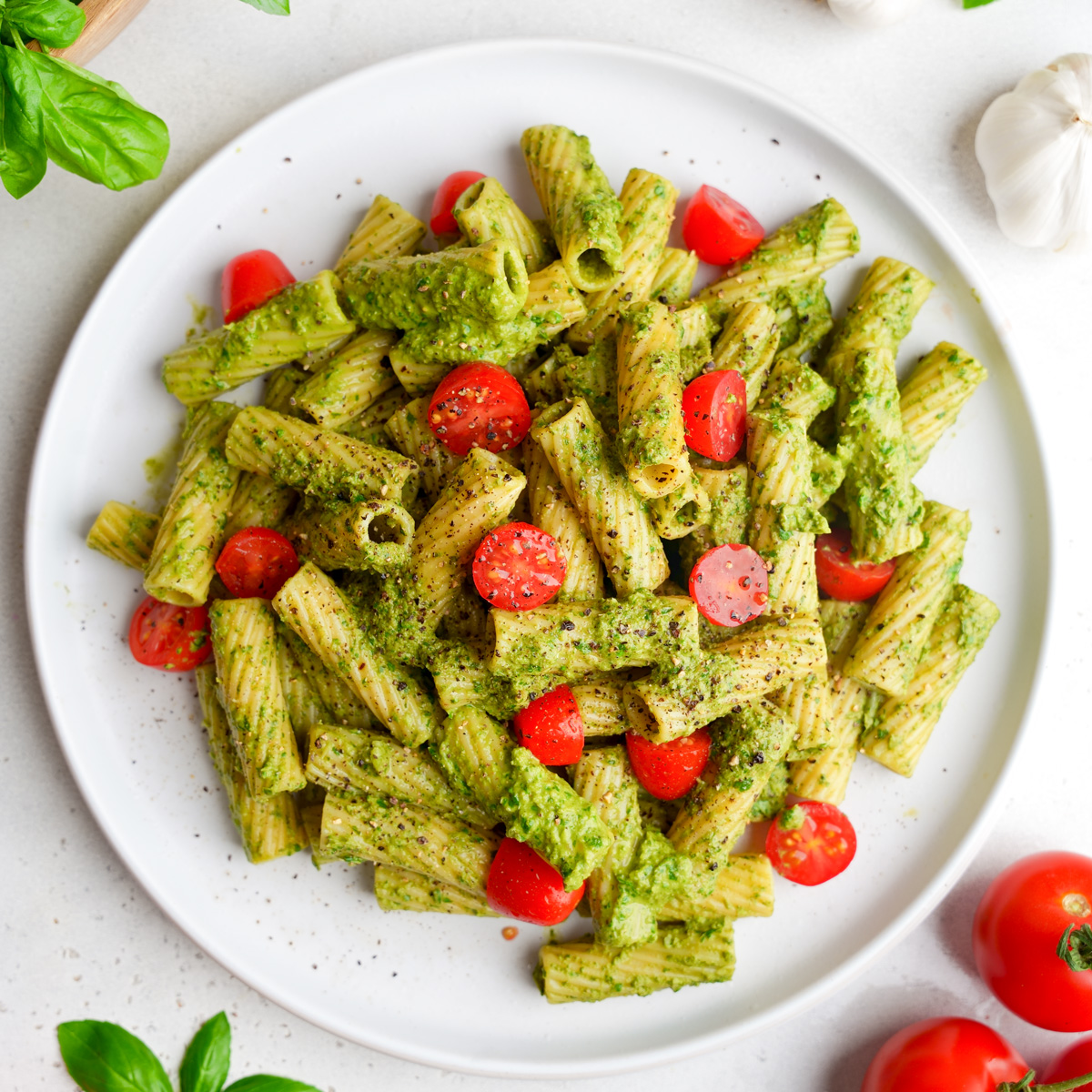
A vibrant bowl of nut-free pesto, ready to elevate your meals.
Pesto is a timeless Italian sauce that captures the essence of summer with its fresh, herbaceous flavors and versatile applications. Traditionally made with pine nuts, this beloved condiment has evolved to accommodate modern dietary needs, leading to the rise of nut-free pesto. Perfect for those with nut allergies or simply seeking a budget-friendly alternative, nut-free pesto swaps nuts for seeds or other binders while retaining the sauce’s signature brightness and richness. Whether drizzled over pasta, spread on sandwiches, or used as a pizza base, this allergy-friendly version promises the same delightful punch without the risk.
In this comprehensive guide, we’ll explore everything you need to master nut-free pesto at home. From its historical roots in Italian cuisine to step-by-step recipes, nutritional insights, and creative twists, this article is your ultimate resource for creating a sauce that’s safe, delicious, and endlessly adaptable. We’ll cover expert tips, pairings, and common pitfalls, ensuring you can whip up a batch in minutes. Ideal for busy cooks, families with allergies, or anyone craving a fresh twist on a classic, nut-free pesto opens up a world of culinary possibilities.
For more Italian-inspired recipes, check out our Classic Basil Pesto or Vegan Sauce Collection. For external resources, the https://tastetrove.net/ offers a deep dive into its origins.
The Rich History of Pesto: From Ancient Roots to Nut-Free Innovations
Pesto’s story begins in the sun-drenched hills of Liguria, Italy, where the sauce originated in Genoa during the Renaissance era. The name “pesto” derives from the Italian verb “pestare,” meaning “to pound” or “to crush,” reflecting the traditional mortar-and-pestle method of preparation. Historical records trace a precursor to pesto back to the Roman Empire, with a sauce called “moretum” made from herbs, cheese, garlic, and olive oil—ingredients strikingly similar to modern pesto.
By the 19th century, the classic Genovese pesto recipe solidified, featuring fresh basil, pine nuts, garlic, Parmigiano-Reggiano or Pecorino cheese, extra-virgin olive oil, and coarse sea salt. Pine nuts, harvested from Mediterranean pine trees, provided a creamy texture and subtle sweetness, but they weren’t always universal. Early variations used walnuts or almonds, depending on regional availability. The sauce gained international fame in the mid-20th century as Italian immigrants brought it to the Americas, where it adapted to local ingredients.
The nut-free evolution emerged in the late 20th century, driven by rising nut allergies and cost concerns. Pine nuts became expensive due to global demand and harvesting challenges, prompting home cooks and chefs to experiment with substitutes like sunflower seeds, pumpkin seeds, or even breadcrumbs for texture. This adaptation not only made pesto accessible to those with tree nut allergies—affecting about 1% of the global population—but also aligned with sustainable cooking trends, as seeds are often more eco-friendly and affordable.
Today, nut-free pesto represents culinary inclusivity, appearing in school lunches, allergy-friendly restaurants, and home kitchens worldwide. Its history underscores pesto’s adaptability, from ancient Roman herb pastes to contemporary seed-based versions. For more on Italian sauce evolution, visit our History of Italian Sauces or explore Eataly’s pesto guide. Understanding this background adds depth to your cooking, inspiring experiments with traditional techniques in a modern, safe way.
Pesto’s cultural significance extends beyond Italy. In the U.S., it surged in popularity during the 1980s health food boom, praised for its fresh ingredients. Nut-free versions gained traction in the 2000s with increased allergy awareness, leading to commercial products and recipes tailored for schools and hospitals. Globally, variations incorporate local herbs, like cilantro in Mexican-inspired pestos or mint in Middle Eastern twists, showcasing the sauce’s versatility. This ongoing innovation keeps pesto relevant, blending heritage with health-conscious adaptations.
Nutritional Benefits: Why Nut-Free Pesto is a Health Powerhouse

Nutrient-packed nut-free pesto, highlighting its health benefits.
Nut-free pesto isn’t just a safe alternative—it’s a nutritional gem, packed with vitamins, minerals, and antioxidants from its wholesome ingredients. Swapping pine nuts for seeds like sunflower or pumpkin enhances its health profile while maintaining creaminess.
Basil, the star herb, is rich in vitamin K (up to 1,000% DV per cup), supporting bone health and blood clotting. It’s also loaded with vitamin A for vision and immune function, plus antioxidants like eugenol that combat inflammation and oxidative stress. Garlic adds allicin, a compound with antibacterial properties, potentially lowering cholesterol and boosting heart health.
Sunflower seeds, a common nut substitute, provide vitamin E (an antioxidant for skin and cell protection), magnesium for muscle function, and healthy fats that promote satiety. They’re lower in calories than pine nuts and offer selenium for thyroid health. Parmesan cheese contributes protein (about 10g per ounce) and calcium for bones, while olive oil’s monounsaturated fats support cardiovascular health and reduce inflammation.
A 1/4 cup serving of nut-free pesto typically has 200-300 calories, with 20g fat (mostly healthy), 5g protein, and low carbs. It’s gluten-free and can be vegan with cheese substitutes like nutritional yeast, adding B vitamins. Compared to traditional pesto, nut-free versions may have more fiber from seeds, aiding digestion.
For those with allergies, this pesto eliminates tree nut risks while delivering similar benefits. It’s heart-healthy, anti-inflammatory, and versatile for balanced diets. Check our Guide to Healthy Sauces or Healthline’s basil benefits. Incorporate it into meals for a nutrient boost without compromise.
Expanding on benefits, basil’s essential oils may alleviate stress and improve mood, while garlic’s sulfur compounds support detoxification. Sunflower seeds add zinc for immunity, making this pesto a cold-season ally. Olive oil’s polyphenols fight chronic diseases, and the sauce’s low glycemic index suits diabetics. Overall, nut-free pesto is a smart, flavorful choice for wellness-focused eating.
Essential Ingredients for Perfect Nut-Free Pesto

Fresh ingredients ready for blending into nut-free pesto.
Quality ingredients are the foundation of great pesto. For about 1 cup of sauce:
| Ingredient | Quantity | Notes |
|---|---|---|
| Fresh basil leaves | 2 cups, packed | Sweet Genovese variety for authenticity; organic for purity. |
| Sunflower seeds (or pumpkin seeds) | 1/3 cup | Toasted for nutty flavor; unsalted to control saltiness. |
| Parmesan cheese, grated | 1/2 cup | Freshly grated for meltability; Pecorino for sharper taste. |
| Garlic cloves | 2-3 | Adjust for intensity; roast for milder flavor. |
| Extra-virgin olive oil | 1/2 cup | High-quality for smoothness; add gradually. |
| Lemon juice | 1 tbsp | Fresh for brightness; prevents oxidation. |
| Salt | 1/2 tsp | Sea salt to enhance flavors. |
| Black pepper | To taste | Freshly ground for aroma. |
These yield a gluten-free, vegetarian sauce. Substitutes: Nutritional yeast for vegan, breadcrumbs for seed-free. Source basil fresh from gardens or markets. For tips, see Simply Recipes’ pesto basics.
Detailing selections, basil should be vibrant without spots. Sunflower seeds are affordable and neutral, mimicking pine nuts’ texture. Garlic adds punch but can overpower—start with two cloves. Olive oil’s fruitiness is key; use less for thicker pesto. Lemon juice brightens and preserves color. This combination ensures a balanced, allergy-safe sauce.
Step-by-Step Guide: Making Nut-Free Pesto at Home

Step-by-step process of blending nut-free pesto.
Creating nut-free pesto is quick—ready in 10 minutes. This recipe yields 1 cup.
- Toast the Seeds: In a dry skillet over medium heat, toast 1/3 cup sunflower seeds for 3-5 minutes until golden. Cool slightly. This enhances nuttiness without nuts.
- Prepare Ingredients: Wash and dry 2 cups basil leaves. Peel 2-3 garlic cloves. Grate 1/2 cup Parmesan.
- Blend Base: In a food processor, pulse garlic and seeds until finely chopped.
- Add Herbs and Cheese: Add basil, cheese, salt, pepper, and lemon juice. Pulse to combine.
- Emulsify with Oil: With processor running, drizzle in 1/2 cup olive oil until smooth. Adjust consistency.
- Taste and Adjust: Season as needed. Store in a jar with oil layer to prevent browning.
For visuals, see The Kitchn’s pesto methods. This method preserves bright color and flavor.
Expanding, food processors are ideal for even texture, but blenders work—add oil first to ease blending. Mortar-and-pestle yields rustic pesto, crushing oils for deeper aroma. Avoid over-blending to prevent bitterness from basil.
8 Expert Secrets for Mastering Nut-Free Pesto
- Toast Seeds Properly: Enhances flavor; don’t burn.
- Use Fresh Basil: Dry thoroughly to avoid watery pesto.
- Balance Garlic: Roast for sweetness.
- Drizzle Oil Slowly: For emulsion.
- Add Acid Early: Lemon prevents discoloration.
- Customize Texture: Pulse for chunky, blend for smooth.
- Store Smart: Refrigerate up to 5 days; freeze in cubes.
- Experiment Substitutes: Try pepitas or hemp seeds.
See our Pesto Troubleshooting or Food Republic’s swaps.
Detailing, toasting releases oils, mimicking nuts. Fresh basil is crucial—wilted leaves dull flavor. Garlic quantity varies by preference; start low. Slow oil addition creates creaminess. Acid brightens and stabilizes. Texture affects use—chunky for dips, smooth for pasta. Storage: Oil top prevents air exposure; freeze for 3 months. Substitutes like seeds add unique notes, e.g., pepitas for earthiness.
Creative Variations to Elevate Your Nut-Free Pesto

Variety of dishes featuring nut-free pesto variations.
Nut-free pesto is versatile. Vegan: Use nutritional yeast instead of cheese. Dairy-free: Same, with olive oil emphasis. Herb swaps: Arugula for peppery, spinach for mild. Seed options: Pumpkin for sweetness, hemp for protein.
Red pesto: Add sun-dried tomatoes. Kale pesto: For nutrition boost. Breadcrumb version: For ultra-nut-free. Explore our Vegan Pesto Recipes or Yummy Toddler Food’s ideas.
More variations: Cilantro-lime for Mexican flair, mint-pea for spring freshness. Low-oil: Use water or broth. These keep pesto exciting, suiting diets and seasons.
Ideal Pairings: Dishes, Wines, and Serving Ideas
Pair with pasta for classics like pesto genovese. Spread on pizza, sandwiches, or grilled veggies. Mix into soups or salads.
Wines: Crisp whites like Sauvignon Blanc balance richness. Sides: Roasted potatoes, caprese salad.
Serve as dip with bread or marinade for chicken. See our Italian Pairings or Real Food with Sarah’s uses.
Expand: Pasta shapes like trofie hold sauce well. Pizza: Top with mozzarella, tomatoes. Sandwiches: With turkey, avocado. Versatile for breakfast eggs or grain bowls.
Frequently Asked Questions About Nut-Free Pesto
Is it as flavorful as traditional? Yes, seeds provide similar texture.
Storage time? Fridge: 5-7 days; freeze: 3 months.
Vegan options? Use yeast or vegan cheese.
Calories? About 100 per tbsp.
See Mommy’s Home Cooking recipes.
More: Sub for basil? Spinach or kale. Thicken? Add more seeds. Allergies? Check seeds for cross-contamination.
Savor the Freshness of Nut-Free Pesto

Delicious pasta dish topped with nut-free pesto.
Nut-free pesto blends tradition with inclusivity, offering a safe, nutritious sauce for all. With these 8 secrets, you’ll craft versions that delight. Experiment and enjoy. Try our Arugula Pesto next. Buon appetito!
